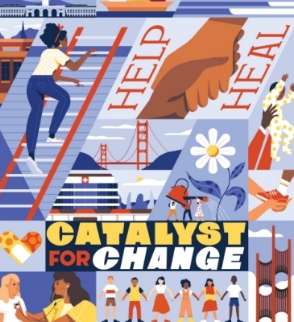Genentech Oncology
Featured Initiative: 4R Oncology Care Coordination Tool
Right Information and Right Care for the Right Patient at the Right Time
Problem
- Cancer care requires careful timing and coordination of services. Genetic testing often takes place before surgery, and fertility preservation must be considered before chemotherapy, but coordination may be difficult when several medical specialists are involved in a patient’s care1
- These challenges are magnified in settings that treat underserved patients, potentially leading to suboptimal treatment decisions and outcomes1
An example of how we’re addressing the problem
Cancer care that puts patients in the driver’s seat, empowering them to plan and manage their care to the extent they are willing and able. Genentech partnered with researchers from Center for Business Models in Health Care to develop and validate a care coordination tool that can be leveraged by interested healthcare organizations.

What is 4R?
A care sequence tool for people with breast and lung cancer and the institutions that treat them. 4R aims to empower patients, allowing them to collaborate with their healthcare team to develop a personalized plan that fits their needs, including critical steps such as biomarker testing.1-5
The 4R tool includes:
- a personalized and patient-centric care plan—developed collaboratively between each patient and their healthcare providers—that addresses medical as well as social, logistical, and financial needs1
- summary information about the patient’s cancer
- care checklist
- graph depicting timing and sequence of care
- responsibilities of the patient and their care team; contact information for care team
- coordination between different specialties to provide the best care at the optimal time2

Sample care sequence document. © Copyright 2021. Executive Frameworks, Ltd., aka Center for Business Models in Healthcare.
4R was evaluated in:
- Several hospitals, including “safety-net” institutions with large populations of socioeconomically underserved patients
- Patients with breast cancer and lung cancer
- The evaluation compared the 4R intervention cohort with a historical cohort drawn from respective institutions
How well does 4R work?
This tool helped organize my schedule. Kept me informed. ‘Go to’ resource, when I needed it.

—patient who received cancer care using the 4R model
4R provided clarity of what to expect and my responsibilities.

—patient who received cancer care using the 4R model
Extremely helpful roadmap to help patients understand what care should be done sooner than other care (ie, tests/imaging before treatment decisions).

—healthcare provider who used 4R in their practice
I believe 4R will be a permanent part of my practice moving forward.

—healthcare provider who used 4R in their practice
The 4R tool was associated with improvements in patient self-management, patient satisfaction with care, care delivery,3 and self-reported provider effectiveness.4
Adoption of 4R also contributed to patient-centric care by decreasing the turnaround time for genetic testing results, enabling more informed discussions between patients and providers.5
Provider-reported impact of 4R4
Does the 4R oncology model improve clinicians’ effectiveness in patient-facing planning of complex cancer care?
Patient-reported impact of 4R3
4R was associated with improvements in patient-reported satisfaction with care.
Among people with lung and breast cancer,
88%
of patients who used the 4R tool reported that healthcare providers were respectful,
COMPARED WITH
78%
of patients who did not use 4R
76%
of patients who used the 4R tool reported that healthcare providers explained things in a way that was easy to understand,
COMPARED WITH
59%
of patients who did not use 4R

4R may help reduce disparities in care.
In one study, patients treated in “safety-net” settings benefited from 4R at similar or higher rates than patients in standard settings.1
Related case study: Genentech & the American Cancer Society: Empowering Communities with Access, Together

-
-
Trosman J, Weldon C, Rapkin B, et al. Evaluation of the novel 4R oncology care planning model in breast cancer: impact on patient self-management and care delivery in safety-net and non–safety-net centers. JCO Oncol Pract. 2021;17(8):e1202-e1214. doi:10.1200/OP.21.00161
Trosman J, Weldon C, Rapkin B, et al. Evaluation of the novel 4R oncology care planning model in breast cancer: impact on patient self-management and care delivery in safety-net and non–safety-net centers. JCO Oncol Pract. 2021;17(8):e1202-e1214. doi:10.1200/OP.21.00161
-
Liu R, Weldon C, Linehan E, et al. Fostering a high-functioning team in cancer care using the 4R oncology model: assessment in a large health system and a blueprint for other institutions. JCO Oncol Pract. 2022;19(1):e125-e137. doi:10.1200/OP.22.00287
Liu R, Weldon C, Linehan E, et al. Fostering a high-functioning team in cancer care using the 4R oncology model: assessment in a large health system and a blueprint for other institutions. JCO Oncol Pract. 2022;19(1):e125-e137. doi:10.1200/OP.22.00287
-
Trosman JR, et al. The impact of 4R Oncology Model on patient self management and satisfaction in lung versus breast cancer. J Clin Oncol. 41, 2023 (suppl 16; abstr e18703)
Trosman JR, et al. The impact of 4R Oncology Model on patient self management and satisfaction in lung versus breast cancer. J Clin Oncol. 41, 2023 (suppl 16; abstr e18703)
-
Trosman JR, et al. Does the 4R oncology model improve clinicians’ effectiveness in patient-facing planning of complex cancer care? J Clin Oncol. 40, 2022 (suppl 28; abstr 344)
Trosman JR, et al. Does the 4R oncology model improve clinicians’ effectiveness in patient-facing planning of complex cancer care? J Clin Oncol. 40, 2022 (suppl 28; abstr 344)
-
Wei J, Weldon C, Trosman J, et al. The impact of the 4R Oncology model on OncotypeDx turnaround time. J Clin Oncol. 2023;41(16):531. doi:10.1200/JCO.2023.41.16_suppl.531
Wei J, Weldon C, Trosman J, et al. The impact of the 4R Oncology model on OncotypeDx turnaround time. J Clin Oncol. 2023;41(16):531. doi:10.1200/JCO.2023.41.16_suppl.531
-
-